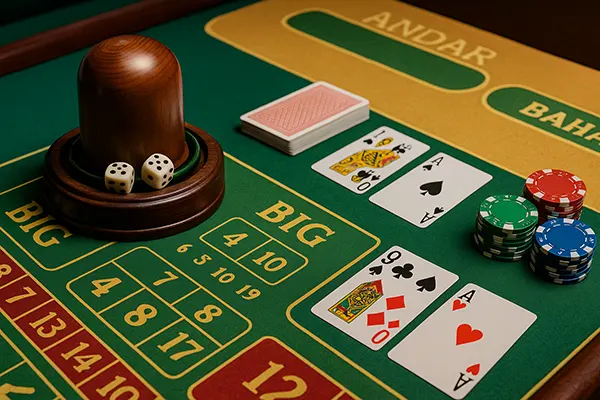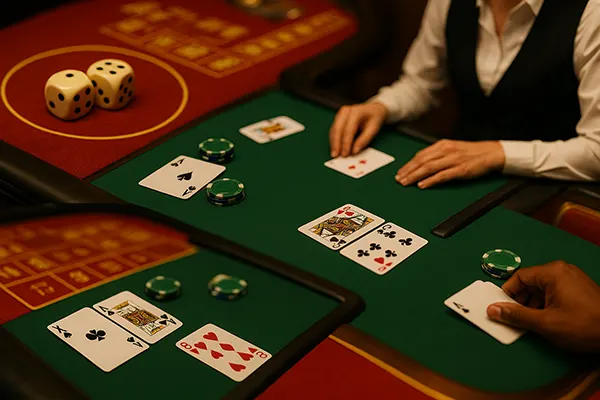
Rare Table Games in Online Casinos: Sic Bo, Andar Bahar, and Teen Patti
While popular table games such as roulette and blackjack dominate most casino catalogues, a number of lesser-known titles continue to attract niche players across different regions. Among these are Sic Bo, Andar Bahar, and Teen Patti — three culturally distinct games that are gaining traction in online formats. Their unique rules, fast-paced gameplay, and rich histories make them worth exploring by anyone looking for alternatives to classic Western games.
Sic Bo: A Dice Game with Deep Asian Roots
Sic Bo, which originated in ancient China, is a fast-paced dice game based on the outcome of three dice. It is known for its wide range of betting options and high volatility. The name translates as “precious dice,” and the game remains one of the most popular dice-based formats in Asia, particularly in Macau and the Philippines.
The basic premise of Sic Bo involves placing wagers on different possible combinations of the three dice. Bets can be placed on specific numbers, totals, pairs, triples, or ranges. Each outcome has different odds and corresponding payouts. This allows for flexible betting strategies, from conservative plays to high-risk wagers with significant returns.
Online versions of Sic Bo use Random Number Generators (RNGs) to ensure fair outcomes, while live dealer formats replicate the physical table environment using real dice and high-definition streaming. These live versions often add value by including multilingual dealers and advanced betting statistics to cater to international players.
Strategic Depth and Payout Potential in Sic Bo
Unlike roulette, Sic Bo requires an understanding of probability and risk assessment across various betting types. Although it’s a game of chance, players often develop systems that balance high-risk and low-risk wagers to manage their bankroll effectively. For example, combining Small/Big bets with Double bets can provide balanced returns over time.
One of the most intriguing aspects is the Triple bet, which pays 180:1 in some versions. However, this bet has very low odds, making it ideal only for those willing to take occasional high-stakes risks. More commonly, players focus on Totals (e.g., 9 or 12), which offer moderate risk and payout.
Live casino operators often enhance Sic Bo with side bets and visual interfaces that help players understand the statistical probability of each outcome. These tools add educational value and reduce the learning curve for new players, particularly in markets outside of Asia where the game is still relatively unknown.
Andar Bahar: A Cultural Favourite from India
Andar Bahar is a straightforward card game deeply rooted in Indian gaming culture. The game is played with a standard 52-card deck and is based on luck, with very minimal strategy involved. Its appeal lies in its simplicity and speed, making it ideal for casual players looking for quick rounds and fast outcomes.
The dealer draws one “joker” card and then deals cards alternately to the Andar (left) and Bahar (right) sides. The objective is to predict which side will receive a card matching the value of the joker first. Payouts vary depending on which side receives the first card and the player’s prediction accuracy.
Online casinos have adapted Andar Bahar with various betting enhancements, including side bets on how many cards will be dealt before a match appears. These additions maintain the simplicity of the core game while providing more excitement for experienced players seeking higher engagement.
Why Andar Bahar Continues to Gain Popularity Online
One of the primary reasons for the growth of Andar Bahar online is its accessibility. The game can be learned within minutes, and its fast gameplay cycle keeps users engaged. Moreover, it appeals to mobile users due to its minimal interface and simple mechanics, making it an ideal choice for gaming on the go.
Operators targeting the Indian market often include Andar Bahar in both RNG and live dealer formats, with the latter providing authentic elements such as regional language dealers and traditional music. This localisation strategy has helped the game build a loyal base not only in India but also among Indian diasporas worldwide.
As international interest in regional games increases, Andar Bahar serves as an excellent example of how cultural specificity can lead to global adoption. Its seamless integration into online gaming catalogues is a testament to its enduring appeal and user-friendly design.

Teen Patti: The Indian Take on Poker
Teen Patti, often referred to as “Indian Poker,” is a three-card game that combines elements of poker and chance. It’s immensely popular during social gatherings and festivals in India and has been adapted successfully into online formats with real-money play and live dealers.
Players are dealt three cards face down and place bets based on their hand strength. The objective is to have the highest-ranking hand among participants or to bluff opponents into folding. Hands are ranked similarly to poker, with combinations like trails (three of a kind), sequences, and flushes.
Online versions of Teen Patti come in multiple variants, including Joker, AK47, and Muflis. These modes offer additional rules and twists to keep the gameplay fresh. Leading casino operators also include side bets and jackpot features to increase potential winnings and attract different player demographics.
Teen Patti’s Evolution and International Reach
What sets Teen Patti apart from classic poker is its cultural significance and the social aspect of gameplay. In its traditional form, the game thrives on friendly competition and local customs, which many live dealer tables try to replicate in the online space through personal interaction and themed visuals.
Over recent years, Teen Patti has expanded beyond Indian markets, finding footholds in regions like the UAE and Southeast Asia. International interest has been boosted by mobile apps and real-money versions offered in multiple languages and currencies.
For online casinos looking to diversify their offerings, Teen Patti represents a compelling addition. Its combination of luck, social engagement, and strategic bluffing aligns well with both casual and experienced players, making it a valuable component of any modern casino catalogue.
